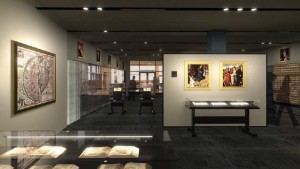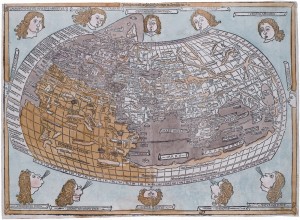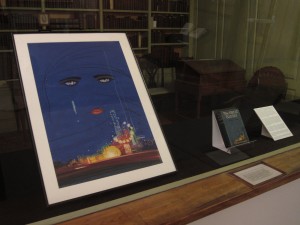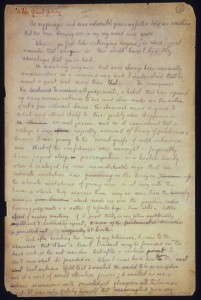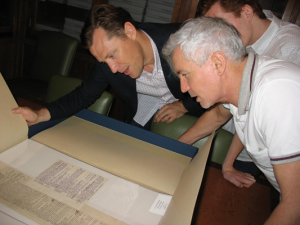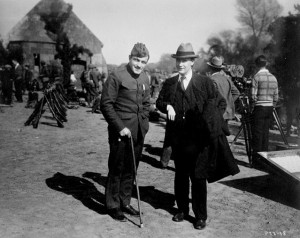The Cotsen Children’s Library will host the conference “Putting the Figure on the Map: Imagining Sameness and Difference for Children” from Wednesday, September 11, through Friday, September 13, 2013. The Conference is geared to professionals and experts in illustrated children’s literature and librarians and K-12 teachers are welcome.
This interdisciplinary program about international illustrated children’s books, co-organized by Emer O’Sullivan and Andrea Immel, will draw on the approaches in imagology, history, anthropology, psychology, and literary criticism. It will focus on modes of expression arising within or outside the classroom that either target children or appropriate discourses for them that create competing, complimentary, or contradictory images of foreign nations and their peoples. The program will also feature a workshop featuring primary resources from the Cotsen collection.
Registration is free to Princeton University students, faculty and staff; $25 for all others. To register online, visit:
http://www.princeton.edu/cotsen/research-collection/academic-conferences/imagining/
Visit the conference website for speaker biographies and abstracts at:
http://www.princeton.edu/cotsen/research-collection/academic-conferences/imagining/
For more information, please contact Andrea Immel, Curator, Cotsen Children’s Library, at aimmel@princeton.edu.
The Cotsen Children’s Library is a unit within the Department of Rare Books and Special Collections in Princeton’s Firestone Library. The gift of Lloyd E. Cotsen, Class of 1950, Charter Trustee, and collector, Cotsen is home to one of the world’s greatest collections of international historical illustrated children’s books, prints, manuscripts, original artwork, and educational toys.
For directions to the Cotsen Children’s Library: http://www.princeton.edu/cotsen/aboutus/directions
COTSEN CONFERENCE SCHEDULE
11 September 2013
5:30 pm – 7:00 pm: Reception (Cotsen Children’s Library, Firestone Library)
12 September 2013 (All activities Thursday take place at Friend Center, William Street, Room 113, unless otherwise noted.)
9:30 am – 10:15 am: Registration and coffee
10:15 am – 10:30 am: Welcome
10:30 am – 12:00 pm: Session 1 Ethnography on Display
- Emer O’Sullivan “Picturing the World for Children: Early Nineteenth-Century Images of Foreign Nations”
- Gillian Lathey “Figuring the World: Representing Children’s Encounters with Other Peoples and Cultures at the 1851 Great Exhibition”
- Silke Meyer (via Skype) “Politics in the Children’s Perspective: National Stereotypes in Eighteenth- and Nineteenth-Century Prints”
12:30 pm – 2:00 pm: Lunch
2:00 pm – 3:15 pm: Session 2 Images Instrumentalized
- Martina Seifert “Appropriating the Wild North: The Image of Canada and Its Exploitation in German Children’s Literature”
- Lara Saguisag “Foreign Yet Familiar: Theorizing the Immigrant Child in Progressive Era Comic Strips 1896-1912”
3:15 pm – 3:30 pm: Break
3:30 pm – 5:00 pm:
- Amanda Brian “Civilizing Children and Animals in Lothar Meggendorfer’s Moveable Books”
- Eric J. Johnson “Teaching How to Hate: Oncle Hansi’s Pedagogial Polemic and the Question of Alsatian Nationalism”
13 September 2013 (Venue to be announced.)
10:00 am – 12:00 pm: Session 3 Internationalism, Pacifism, and Tolerance, I
- Nina Christensen “Education to Tolerance: Citizens of the World in Eighteenth-Century Children’s Literature and Children’s Literature of Today”
- Cynthia Koepp “An Anthropologist Shows Children a World of Difference: The Pedagogical Imagination of Louis-François Jauffret”
- Minjie Chen “Foreigners Not (Yet) in One Box: Discourse on Race and Foreign Nationals in Chinese Children’s Reading Materials 1890-1920
12:00 pm – 1:15 pm: Lunch
1:15 pm – 3:00 pm: Session 4 Internationalism, Pacifism, and Tolerance, II
- Farah Mendlesohn “National Characters, National Character: Children in Pacifist and Anti-Militaristic Publications for Children Between the Wars”
- Gabriele von Glasenapp “Information or Exoticization?: Constructing Religious Difference in Children’s Non-Fiction”
- Margaret R. Higonnet “No Child Is an Island”
3:30 pm – 5:00 pm: Session V Primary Materials Workshop (Cotsen Children’s Library, Firestone Library)
- Jill Shefrin “Pictures for Tarry-at-home Travellers”
- Setsuko Noguchi “Around the World in One Game: Japanese Picture Sugoroku”
5:00 pm: Closing words



